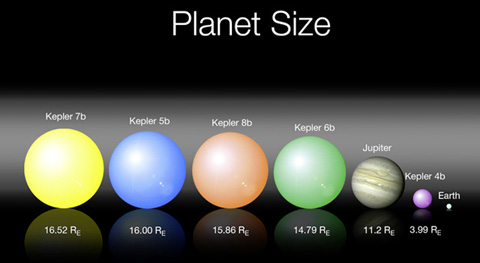Spacecraft Kepler discovers five extrasolar planets
By Bryan Dyne
2 February 2010
NASA reported last month that Kepler, the first spacecraft dedicated to searching for planets beyond our solar system, has discovered its first five extrasolar planets. Though they are uninhabitable for Earth-like life—four of the five are even larger than Jupiter—their rapid discovery indicates that Kepler is fully capable of achieving its primary mission, finding a planet resembling Earth, in future years.
Kepler was launched in March 2009, and the five planets were detected during the first six weeks of data collection, but it required many months of observation and processing to confirm the discoveries.
The planets that were found, named Kepler 4b, 5b, 6b, 7b, and 8b, are extremely large compared to what is found in our solar system. The smallest is approximately the size of Neptune, or four times the size of Earth. The others are approximately five times the size of Jupiter, the largest planet in the solar system, putting them in the size range of most of the other 400 extrasolar planets currently known. The other planets were found by ground-based observations.
 NASA diagram comparing the newly discovered planets to Jupiter and the Earth
NASA diagram comparing the newly discovered planets to Jupiter and the EarthKepler discovered these planets by constantly watching the 150,000 stars it has in its field of vision, constantly looking for periodic drops in brightness in each star caused by a planet passing between Kepler and the star. Complications arise because sunspots, for example, can also cause the star’s brightness to dim. However, the scientists working for Kepler are fully aware of these issues, and take them into account.
The five planets themselves orbit very near to their parent star, with orbital periods ranging from 3.3 to 4.9 Earth days, which helped lead to their quick discovery. The main reason planets with orbits further out from their stars are less frequently discovered is because it takes longer for them to complete a rotation and pass in front of the star. The periodic drop in the star’s brightness needs to happen at least three times before the planet is confirmed. Thus, anything with an orbital period of a year will take three years to confirm. In contrast, a planet like Kepler 5b has an orbital period of 4 days, needing only 12 days for confirmation.
Not only are these planets much closer to their star than those in our solar system, they are much hotter as well. The hottest planet in our solar system is Venus, at 735 degrees Kelvin (K) (about 300 degrees Centigrade). These planets fall in the ranges of 1500-2000 K, because their extreme proximity to their parent star means they absorb far more radiation.
The Kepler mission is slated to run to at least November 2012, the time it will take to gather enough data to confirm planets in orbits similar to Earth. It is hoped that the telescope will take after the many other scientific instruments that NASA uses, the most famous being Hubble, and continue working for much longer than it is scheduled to.
Now that Kepler’s effectiveness in discovering new planets has been confirmed, the team led by William Borucki is going to sift through the eight months of additional data to look for more extrasolar planets. While the likelihood of this data being able to confirm an Earth-like planet is slim, there is likely to be evidence of planets with longer orbital periods, increasing our knowledge of a yet little understood natural phenomenon.
The author also recommends:
New telescope to search for Earth-sized planets
[24 March 2009]





Follow the WSWS